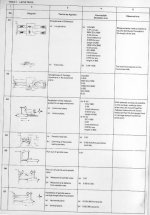Jay,
True we are not talking about target rifle chambers, but we are talking metal working fundamentals. Much of the process is similar, the hydraulic ports and valve spool chambers still must be to an exact size, in an exact location and most importantly not be "egged".
We used to run undersize spade drills and end mills in to remove most of the stock before porting and pre setting shoulders and such. At one point we were even going in with tiny carbide boring bars but the end result after porting still required excessive honing to make the tolerance. For a period of time last year, the hone department couldnt even hone the egg shape out and stay in the dimensional tolerance over the entire valve bank. You know if the hole is honed out to size and the left side sits further left than its supposed to, it is still non conformant. Dang those iso and military inspectors.
The question that I'm asking is: if you increase tool pressure on the reamer by making it work in a 100% cut rather than a 10% cut, is there a chance the reamer would have a greater affinity to follow the pilot hole, meaning the rifle bore?
I don't have the answers other than to say that a process changed at work has drastically improved the quality of the stuff I been making.
Thanks Wayne Shaw,
different way of looking at the whole relationship between shop activity and range results, although related, I agree the outcome is likely too small to be quantified.
Mike
True we are not talking about target rifle chambers, but we are talking metal working fundamentals. Much of the process is similar, the hydraulic ports and valve spool chambers still must be to an exact size, in an exact location and most importantly not be "egged".
We used to run undersize spade drills and end mills in to remove most of the stock before porting and pre setting shoulders and such. At one point we were even going in with tiny carbide boring bars but the end result after porting still required excessive honing to make the tolerance. For a period of time last year, the hone department couldnt even hone the egg shape out and stay in the dimensional tolerance over the entire valve bank. You know if the hole is honed out to size and the left side sits further left than its supposed to, it is still non conformant. Dang those iso and military inspectors.
The question that I'm asking is: if you increase tool pressure on the reamer by making it work in a 100% cut rather than a 10% cut, is there a chance the reamer would have a greater affinity to follow the pilot hole, meaning the rifle bore?
I don't have the answers other than to say that a process changed at work has drastically improved the quality of the stuff I been making.
Thanks Wayne Shaw,
different way of looking at the whole relationship between shop activity and range results, although related, I agree the outcome is likely too small to be quantified.
Mike
Last edited:


